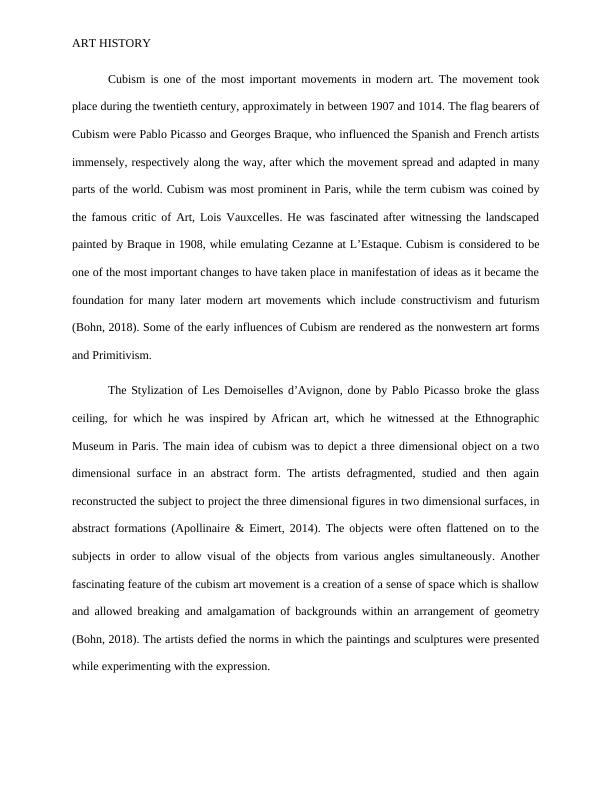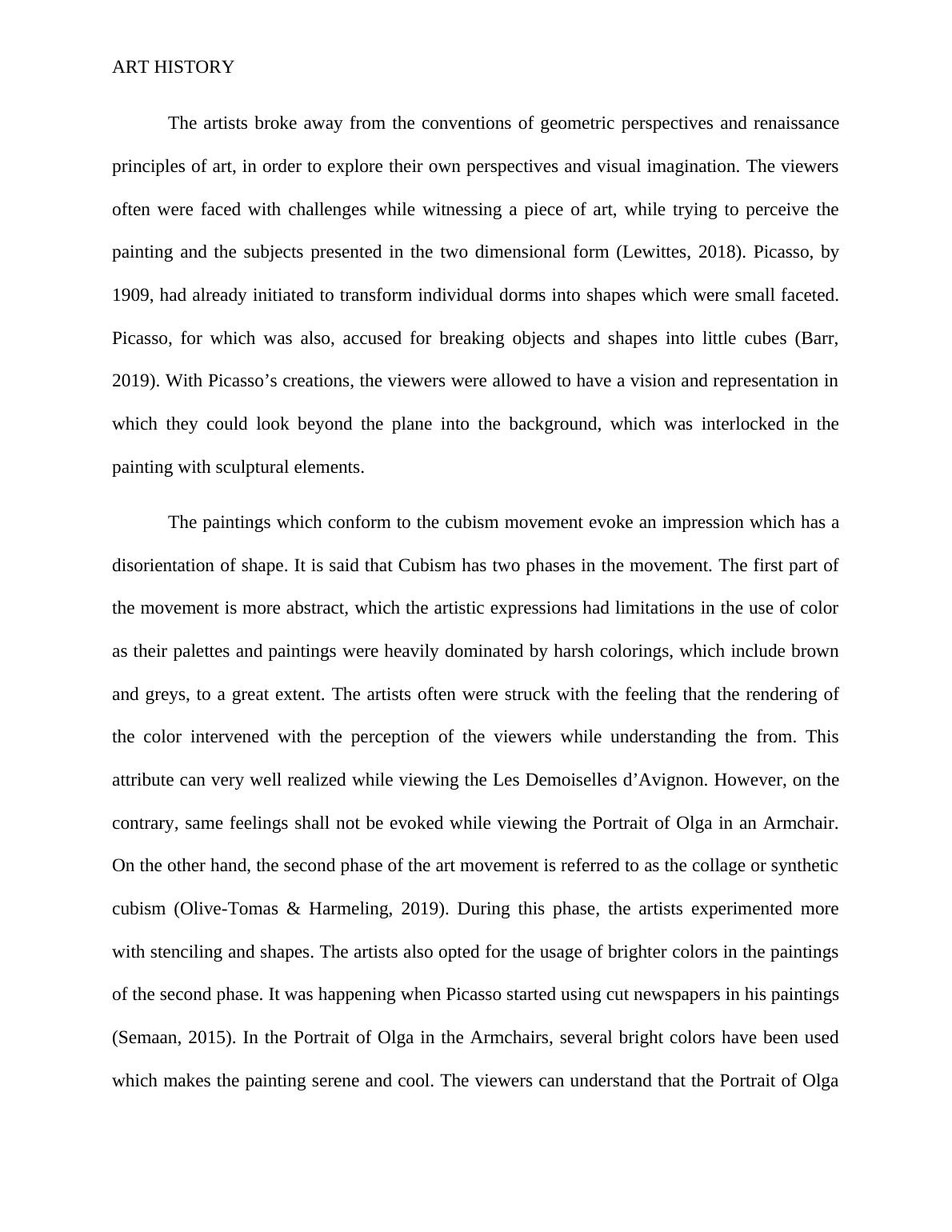The flag bearers of Cubism
Added on 2022-08-29
9 Pages1245 Words21 Views
1
Running head: ART HISTORY
Ancient History
Name of the Student:
Name of University:
Author Note
Running head: ART HISTORY
Ancient History
Name of the Student:
Name of University:
Author Note

ART HISTORY
Cubism is one of the most important movements in modern art. The movement took
place during the twentieth century, approximately in between 1907 and 1014. The flag bearers of
Cubism were Pablo Picasso and Georges Braque, who influenced the Spanish and French artists
immensely, respectively along the way, after which the movement spread and adapted in many
parts of the world. Cubism was most prominent in Paris, while the term cubism was coined by
the famous critic of Art, Lois Vauxcelles. He was fascinated after witnessing the landscaped
painted by Braque in 1908, while emulating Cezanne at L’Estaque. Cubism is considered to be
one of the most important changes to have taken place in manifestation of ideas as it became the
foundation for many later modern art movements which include constructivism and futurism
(Bohn, 2018). Some of the early influences of Cubism are rendered as the nonwestern art forms
and Primitivism.
The Stylization of Les Demoiselles d’Avignon, done by Pablo Picasso broke the glass
ceiling, for which he was inspired by African art, which he witnessed at the Ethnographic
Museum in Paris. The main idea of cubism was to depict a three dimensional object on a two
dimensional surface in an abstract form. The artists defragmented, studied and then again
reconstructed the subject to project the three dimensional figures in two dimensional surfaces, in
abstract formations (Apollinaire & Eimert, 2014). The objects were often flattened on to the
subjects in order to allow visual of the objects from various angles simultaneously. Another
fascinating feature of the cubism art movement is a creation of a sense of space which is shallow
and allowed breaking and amalgamation of backgrounds within an arrangement of geometry
(Bohn, 2018). The artists defied the norms in which the paintings and sculptures were presented
while experimenting with the expression.
Cubism is one of the most important movements in modern art. The movement took
place during the twentieth century, approximately in between 1907 and 1014. The flag bearers of
Cubism were Pablo Picasso and Georges Braque, who influenced the Spanish and French artists
immensely, respectively along the way, after which the movement spread and adapted in many
parts of the world. Cubism was most prominent in Paris, while the term cubism was coined by
the famous critic of Art, Lois Vauxcelles. He was fascinated after witnessing the landscaped
painted by Braque in 1908, while emulating Cezanne at L’Estaque. Cubism is considered to be
one of the most important changes to have taken place in manifestation of ideas as it became the
foundation for many later modern art movements which include constructivism and futurism
(Bohn, 2018). Some of the early influences of Cubism are rendered as the nonwestern art forms
and Primitivism.
The Stylization of Les Demoiselles d’Avignon, done by Pablo Picasso broke the glass
ceiling, for which he was inspired by African art, which he witnessed at the Ethnographic
Museum in Paris. The main idea of cubism was to depict a three dimensional object on a two
dimensional surface in an abstract form. The artists defragmented, studied and then again
reconstructed the subject to project the three dimensional figures in two dimensional surfaces, in
abstract formations (Apollinaire & Eimert, 2014). The objects were often flattened on to the
subjects in order to allow visual of the objects from various angles simultaneously. Another
fascinating feature of the cubism art movement is a creation of a sense of space which is shallow
and allowed breaking and amalgamation of backgrounds within an arrangement of geometry
(Bohn, 2018). The artists defied the norms in which the paintings and sculptures were presented
while experimenting with the expression.

ART HISTORY
The artists broke away from the conventions of geometric perspectives and renaissance
principles of art, in order to explore their own perspectives and visual imagination. The viewers
often were faced with challenges while witnessing a piece of art, while trying to perceive the
painting and the subjects presented in the two dimensional form (Lewittes, 2018). Picasso, by
1909, had already initiated to transform individual dorms into shapes which were small faceted.
Picasso, for which was also, accused for breaking objects and shapes into little cubes (Barr,
2019). With Picasso’s creations, the viewers were allowed to have a vision and representation in
which they could look beyond the plane into the background, which was interlocked in the
painting with sculptural elements.
The paintings which conform to the cubism movement evoke an impression which has a
disorientation of shape. It is said that Cubism has two phases in the movement. The first part of
the movement is more abstract, which the artistic expressions had limitations in the use of color
as their palettes and paintings were heavily dominated by harsh colorings, which include brown
and greys, to a great extent. The artists often were struck with the feeling that the rendering of
the color intervened with the perception of the viewers while understanding the from. This
attribute can very well realized while viewing the Les Demoiselles d’Avignon. However, on the
contrary, same feelings shall not be evoked while viewing the Portrait of Olga in an Armchair.
On the other hand, the second phase of the art movement is referred to as the collage or synthetic
cubism (Olive-Tomas & Harmeling, 2019). During this phase, the artists experimented more
with stenciling and shapes. The artists also opted for the usage of brighter colors in the paintings
of the second phase. It was happening when Picasso started using cut newspapers in his paintings
(Semaan, 2015). In the Portrait of Olga in the Armchairs, several bright colors have been used
which makes the painting serene and cool. The viewers can understand that the Portrait of Olga
The artists broke away from the conventions of geometric perspectives and renaissance
principles of art, in order to explore their own perspectives and visual imagination. The viewers
often were faced with challenges while witnessing a piece of art, while trying to perceive the
painting and the subjects presented in the two dimensional form (Lewittes, 2018). Picasso, by
1909, had already initiated to transform individual dorms into shapes which were small faceted.
Picasso, for which was also, accused for breaking objects and shapes into little cubes (Barr,
2019). With Picasso’s creations, the viewers were allowed to have a vision and representation in
which they could look beyond the plane into the background, which was interlocked in the
painting with sculptural elements.
The paintings which conform to the cubism movement evoke an impression which has a
disorientation of shape. It is said that Cubism has two phases in the movement. The first part of
the movement is more abstract, which the artistic expressions had limitations in the use of color
as their palettes and paintings were heavily dominated by harsh colorings, which include brown
and greys, to a great extent. The artists often were struck with the feeling that the rendering of
the color intervened with the perception of the viewers while understanding the from. This
attribute can very well realized while viewing the Les Demoiselles d’Avignon. However, on the
contrary, same feelings shall not be evoked while viewing the Portrait of Olga in an Armchair.
On the other hand, the second phase of the art movement is referred to as the collage or synthetic
cubism (Olive-Tomas & Harmeling, 2019). During this phase, the artists experimented more
with stenciling and shapes. The artists also opted for the usage of brighter colors in the paintings
of the second phase. It was happening when Picasso started using cut newspapers in his paintings
(Semaan, 2015). In the Portrait of Olga in the Armchairs, several bright colors have been used
which makes the painting serene and cool. The viewers can understand that the Portrait of Olga

End of preview
Want to access all the pages? Upload your documents or become a member.
Related Documents
Discovering Art, Design and Cultural Movementslg...
|7
|1594
|60
Art History Presentationlg...
|13
|1293
|157
Art and Culture: Lessons on Famous Artists and Elements of Artlg...
|11
|1310
|276
Art Movements | Art Historylg...
|6
|1208
|49
Latin American Art History Information 2022lg...
|9
|2353
|24
Comparison of Monet's Gare Saint-Lazare and Cezanne's Mont Sainte-Victoirelg...
|4
|974
|36
